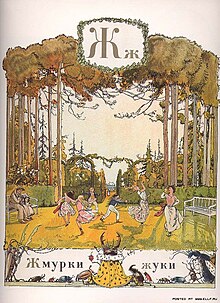Zhe (Cyrillic)

Zhe, Zha, or Zhu, sometimes transliterated as Že (Ж ж; italics: Ж ж) is a letter of the Cyrillic script. It commonly represents the voiced retroflex sibilant /ʐ/ (listen) or voiced postalveolar fricative /ʒ/, like the pronunciation of the ⟨s⟩ in "measure". It is also often used with D (Д) to approximate the sound in English of the Latin letter J with a ДЖ combination. Zhe is romanized as ⟨zh⟩, ⟨j⟩ or ⟨ž⟩.
History
[edit]It is not known how the character for Zhe was derived. No similar letter exists in Greek, Latin or any other alphabet of the time, though there is some graphic similarity with its Glagolitic counterpart Zhivete ⟨Ⰶ⟩ (Image: ![]() ) which represents the same sound. However, the origin of Zhivete, like that of most Glagolitic letters, is unclear.[citation needed]
) which represents the same sound. However, the origin of Zhivete, like that of most Glagolitic letters, is unclear.[citation needed]
One possibility is that it was formed from the pronunciation of Hebrew letter Zayin ⟨ז⟩ combined with the Hebrew letter Shin ⟨ש⟩ letter, to eventually form the Modern Hebrew letter of Zhayin ⟨'ז⟩, with a geresh ⟨'⟩ on top for distinction.
Zhe may also be derived from the Coptic letter janjia ⟨Ϫ⟩, supported by the phonetic value (janjia represents the sound /d͡ʒ/ in Coptic) and shape of the letter, which the Glagolitic counterpart Zhivete ⟨Ⰶ⟩ resembles even more closely. The form of the letter also may be derived from an Egyptian hieroglyph depicting a drill:
| |
It may be a ligature, formed from combining two "K" letters (one backward form) sharing a common stem.[citation needed]
Some Ukrainian scholars argue that it is shape of beetle, since Zhe is the first phoneme in the Slavic word жукъ (žuk), meaning "beetle".[1]
In the Early Cyrillic alphabet the name of Zhe was живѣтє (živěte), meaning "live" (imperative).
Zhe was not used in the Cyrillic numeral system.
Usage
[edit]Zhe is used in the alphabets of all Slavic languages using a Cyrillic alphabet, and of most non-Slavic languages which use a Cyrillic alphabet. The position in the alphabet and the sound represented by the letter vary from language to language.
| Language | Position in alphabet |
Represented sound | Romanization |
|---|---|---|---|
| Belarusian | 8th | voiced retroflex fricative /ʐ/ | zh |
| Bulgarian | 7th | voiced postalveolar fricative /ʒ/ | zh |
| Macedonian | 8th | voiced postalveolar fricative /ʒ/ | ž or zh |
| Russian | 8th | voiced retroflex fricative /ʐ/ | zh |
| Serbian | 8th | voiced retroflex fricative /ʐ/ | ž |
| Ukrainian | 9th | voiced postalveolar fricative /ʒ/ | zh |
| Uzbek (1940–1994) | 8th | voiced postalveolar affricate /dʒ/ or voiced postalveolar fricative /ʒ/ (in Russian loanwords only) | j |
| Mongolian | 8th | voiceless postalveolar affricate /tʃ/ | j |
| Kazakh | 10th | voiced alveolo-palatal fricative /ʑ/, sometimes voiced postalveolar affricate /dʒ/ in speech | j |
| Kyrgyz | 8th | voiced postalveolar affricate /dʒ/ | j |
| Dungan | 8th | voiced retroflex fricative /ʐ/ | r |
| other non-Slavic languages | voiced postalveolar fricative /ʒ/ |
Zhe can also be used in Leet speak or faux Cyrillic in place of the letter ⟨x⟩, or to represent the symbol of the rap duo Kris Kross (a ligature of two back-to-back letter K's).
Transliteration
[edit]Ж is most often transliterated as the digraph ⟨zh⟩ for English-language readers (as in Doctor Zhivago, Доктор Живаго, or Georgy Zhukov, Георгий Жуков). In linguistics and for Central European readers, it is most often transliterated as ⟨ž⟩, with a háček. The scientific transliteration convention comes from Czech spelling and is also used in the Latin alphabets of several other Slavic languages (Slovak, Sorbian, Serbo-Croatian and Slovene). Thus, Leonid Brezhnev's surname (Леонид Брежнев) could be transliterated as "Brežnev", as it is spelled in a number of Slavic languages. Polish uses its own convention for transliteration of Cyrillic according to which ж is transliterated with the Polish letter ż (which is pronounced /ʐ/ in Polish). Ж is often transliterated ⟨j⟩ in Mongolian because of its pronunciation as [t͡ʃ].
Related letters and other similar characters
[edit]- Ӂ ӂ : Cyrillic letter Zhe with breve
- Ź ź : Latin letter Z with acute
- Ž ž : Latin letter Z with caron
- Ż ż : Latin letter Z with dot above
- J j : Latin letter J - the same sound in Romanian, Turkish, Azerbaijani, French, Portuguese, and Catalan
- Ʒ ʒ : Latin letter Ezh
- Җ җ : Cyrillic letter Zhje
- Ӝ ӝ : Cyrillic letter Zhe with diaeresis
Computing codes
[edit]| Preview | Ж | ж | ||
|---|---|---|---|---|
| Unicode name | CYRILLIC CAPITAL LETTER ZHE | CYRILLIC SMALL LETTER ZHE | ||
| Encodings | decimal | hex | dec | hex |
| Unicode | 1046 | U+0416 | 1078 | U+0436 |
| UTF-8 | 208 150 | D0 96 | 208 182 | D0 B6 |
| Numeric character reference | Ж |
Ж |
ж |
ж |
| Named character reference | Ж | ж | ||
| KOI8-R and KOI8-U | 246 | F6 | 214 | D6 |
| Code page 855 | 234 | EA | 233 | E9 |
| Code page 866 | 134 | 86 | 166 | A6 |
| Windows-1251 | 198 | C6 | 230 | E6 |
| ISO-8859-5 | 182 | B6 | 214 | D6 |
| Macintosh Cyrillic | 134 | 86 | 230 | E6 |
See also
[edit]References
[edit]- ^ Вори, Комодори і (2024-08-17). "Літера Ж це зображення жука". Друкарня. Retrieved 2024-08-18.

